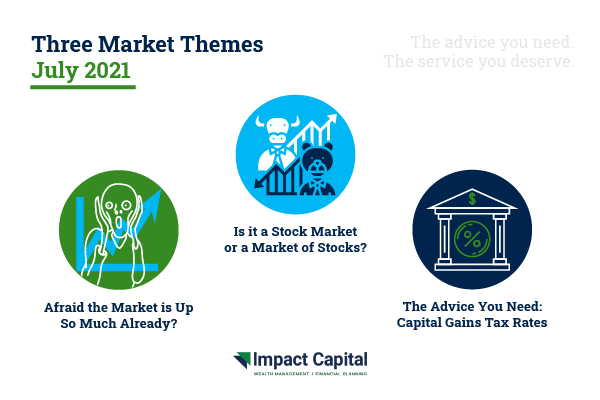
Impact Capital’s quarterly research report seeks to highlight the latest developments most relevant to your investments and financial planning. In this installment of Three Market Themes, we focus on the year-to-date performance of the S&P 500, the recent performance of larger stocks versus smaller stocks, and our advice regarding capital gains tax rates.
1. Afraid the Market is Up So Much Already?
The S&P 500 index ended the first half of the year up 14.4%. This 14.4% return is more than the market usually earns during an average year. It is natural to be curious: How has the market done historically after a strong first half?
In the past, this trend has typically lead to a strong second half of the year, with an average return of 7.1% over the course of that period. The market has been positive 75% of the time. Both measures are above the readings for an average year.
Credit: Ryan Detrick, LPL
2. Is it a Stock Market or a Market of Stocks?
The top chart shows the recent performance of the S&P 500 ETF (SPY). SPY weighs the largest more than the smaller stocks. The bottom chart shows the equally-weighted S&P 500 ETF (RSP).
When SPY moves to new highs and RSP does not, it means the larger stocks are going up more than the smaller stocks. This by itself is no reason for concern unless it reaches an extreme where the market is only held up by a few stocks. For the time being, this is a market trend to monitor, but not a solid reason to change your portfolio.
3. The Advice You Need: Capital Gains Tax Rates
Capital gains tax rates can be different for people with different income levels, and the capital gains tax rate may be as low as 0% for low-income individuals. People in this category should consider realizing capital gains up to the level where the 0% bracket ends.
These differences create opportunities amongst family members to execute creative gifting strategies. A high-income individual could gift a low-income individual appreciated stock instead of cash, and the low-income individual can in turn convert the stock to cash so neither individual has to pay taxes on the gift. High-net-worth parents of college students gifting stocks to their children is a common example in which this gifting strategy applies (limited to $15,000/year per person).
Managing the tax impact from your portfolio will add more value than any investment strategy. Every dollar that avoids capital gains taxation could save you as much as 23.8% — what other investment adds that much value to your assets?
STAY IN THE LOOP



